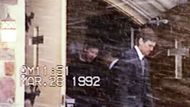Dateline always knows how to grab your attention, and the episode Raising the Dead is one of those stories that does just that. The big question most viewers walk away with is simple. Where is Tony Haase now, and what happened after the Dateline cameras stopped rolling?
The short answer is that Tony Haase is living quietly with his family while he deals with a massive wrongful death lawsuit that is still moving through the system. The long answer is a lot heavier, and that is what we are diving into here.
Dateline: Following the paper trail of a case that refused to die
For fans who have followed Dateline for years, the Raising the Dead episode felt like a cold case that never wanted to rest. The murders of 23-year-old Tanna Togstad and 35-year-old Timothy Mumbrue in March 1992 left a deep scar on Royalton, Wisconsin.

The NBC show walks us through the horror, but what really shakes people is how this case suddenly came back to life three full decades later. It was like the old files were suddenly breathing again and the whole town was right back in the storm.
Tony Haase’s name did not appear at the start of the original investigation. In fact, back in 1992, nobody looked his way. A lot of people in Waupaca County actually knew his family. He had grown up there, lost his father when he was seven, and lived a pretty quiet adult life.
The true crime show explains how his father died in a horrible snowmobile crash on December 31, 1977. The crash involved one of the same families at the center of this case. Records show that Tony was close to his dad, so that loss stayed with him.
Life moved on and Tony eventually became a husband, a dad, and even a grandfather. He worked at a local foundry. Nothing about him made anyone think he would ever be tied to a violent crime. But in July 2022, during what seemed like a simple traffic stop, investigators collected a pen he had used and sent it for testing.
According to the case records highlighted on Dateline, the Wisconsin State Crime Lab later said the DNA from the pen was “consistent with the profile previously detected” from the crime scene. That was the clue that changed everything.
On August 11, 2022, officers arrested him at his workplace and charged him with two counts of first-degree murder. His bond was set at $2 million. The true crime show shows how fast things moved from there. What shocked people even more was what Tony reportedly told investigators on the day they confronted him.
In the criminal complaint, Tony said he was “afraid he was involved” because he kept experiencing flashes of that night. He said he had been in what he called a “drunken stupor” and remembered getting into a “scuffle” with Timothy. He also said he remembered hearing Tanna scream “what the f**k,” and then he claimed everything went blurry.
The NBC true crime made this moment feel even more surreal because Tony’s story did not sound clean or confident. When detectives asked why he never came forward sooner, he responded,
“I didn’t want it to sound like I had it planned.”
This shows how confused he was. Some people believed he was telling the truth. Others thought that he had been pushed into saying things he did not fully mean.
Inside a trial that pulled the community back into the past
Tony’s trial officially began in July 2025. Prosecutors argued that the DNA matched, the confession mattered, and that Tony alone was responsible for the deaths of Tanna and Timothy. They repeated these points throughout the trial, building their case around science and Tony’s own statements.

But the defense team fought hard. Dateline reporters explained how Tony’s lawyers said the DNA was handled poorly. They argued that the chain of custody was not clear and that contamination was possible.
They also said Tony’s confession was not reliable because of the way detectives had questioned him. According to Dateline and local reports, his defense argued he was misled during the interrogation, and the seven-hour process wore him down.
One of the biggest shocks came when the defense talked about other possible suspects. They mentioned three different men from the community, including Tony’s own uncle, Jeff Tiel, who died in 1995.
The defense said Jeff had a history of violence toward animals, which mattered because the couple’s dog had also been stabbed. They also said Jeff had threatened multiple wives over the years. This part of the trial hit people especially hard because it reminded everyone how messy and complicated long unsolved cases can be.
Dateline highlights how the jury wrestled with all of this. The trial lasted more than three weeks. The jury deliberated for four full days. After all the waiting, the verdict finally arrived on August 11, 2025. Tony Haase was found not guilty. He walked out of the courtroom a free man.
The reactions were emotional on both sides. Tony’s family broke down with relief. But for the victims’ families, it felt like another wound. Dateline shows the pain on their faces. Tanna’s brother, Richard Togstad, spoke openly about his shock. He told WBAY,
“We were waiting 33 years for it, and when it went the other way, I still couldn’t believe it. I still don’t.”
Even after Tony returned home, people kept asking the same question that Dateline viewers were asking. If the jury said he did not do it, then who did? And if he did do it, how could the system not prove it?
What Dateline revealed about the life Tony returned to after his acquittal
Dateline focuses heavily on the crimes, the investigation, and the trial. But a huge part of Raising the Dead is about what happens after the verdict. When Tony left the courtroom, he stepped back into a world that had completely changed.

Wisconsin records show he cannot be charged with these murders again. That protection is something every true crime fan learns about at some point. It is the reality of the justice system and double jeopardy.
But freedom did not mean life suddenly became simple. Dateline explains that even while the trial was still unfolding, Tanna’s brother Richard filed a wrongful death lawsuit against Tony. The lawsuit is huge. It asks for $17 million in damages.
Richard filed it on behalf of their family. He filed it because he believes Tony is still responsible. Richard said his family lived “without closure” for over thirty years. He said they had to go through birthdays, holidays, and the normal moments of life, knowing Tanna never got the same chance.
Dateline also points out something that hit audiences hard. Richard said the thing that hurts him the most is that Tony got to live a full life while his sister never saw past 23.
He said,
“He got to have kids. He got to have grandkids. He got to have all these things. And Tanna got nothing, absolutely nothing, besides dead.”
He said this to WBAY, and hearing it straight from him made the whole case feel even heavier.
Tony responded to the lawsuit through his attorneys. According to NBC 26, he denied the allegations and said he did not have enough knowledge about many of the claims.
He also raised defenses, including a lack of jurisdiction and failure to state a claim. His legal team asked the court to dismiss the lawsuit, but as of the Dateline episode and the latest filings, the case is still active.
Dateline does not try to paint Tony as a hero or a villain. It shows the reality. He went home to his family. He is trying to stay quiet. But he is also living with the weight of a lawsuit that could follow him for years.
It is a strange kind of freedom, the kind that never fully feels peaceful. You can tell that behind the scenes, life probably feels fragile for everyone involved.
Where is Tony Haase now and what comes next for him?
Since Dateline viewers always want the update at the end, Raising the Dead makes sure to show where Tony Haase is right now. His criminal case is finished. He cannot be tried again for these murders. The jury set him free.

After that verdict, he returned to his family in Waupaca County. People who knew him from before say he wants a quiet life. He worked in a local foundry for years and built a life that looked simple from the outside. That is the life he is trying to return to.
But the truth is that his story is not done. The wrongful death lawsuit is still very active, and those legal battles can last a long time. Dateline makes it clear that civil court is its own world. Unlike a criminal court, a civil case does not require proof beyond a reasonable doubt. It focuses on damages. It focuses on responsibility and on closure for the families who feel left behind.
The Dateline episode shows how deeply the Togstad family has suffered. Richard speaks for the family. He says they waited more than thirty years for justice. Then they watched that justice disappear in a courtroom. That is why he filed the lawsuit. He wants the truth to be confronted in some way. Even if the legal system has limits, he wants his sister’s story to be heard.
Tony is staying out of the public eye while this moves forward. Dateline mentions that he has kept to himself and has been focused on his family. After everything that happened, he probably just wants to be quiet. But the case will always follow him. Even if he never returns to a courtroom, his name is tied to one of the most painful cold cases in Wisconsin.
That is where things stand today. Tony is home. The criminal trial is over. The civil case is still active. The community is still divided. Dateline did not close the door on this case. It showed viewers that sometimes justice is complicated and sometimes families never get the answers they hope for.
Dateline made the Raising the Dead episode unforgettable because it shows how a crime can echo through an entire community for decades. Today, Tony Haase is living with his family, but his future is shaped by the massive wrongful death lawsuit still moving forward.
The criminal case may be over forever, yet the emotional weight of the story is still hanging in the air.
Stay tuned to SoapCentral for more.
Also Read: Dateline: Running Man - How did the investigators catch James Schwalm in connection to his wife Ashley Schwalm's murder? Details revealed
